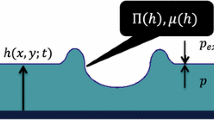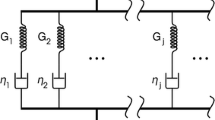Abstract
Heat assisted magnetic recording (HAMR) is a promising technique to overcome the superparamagnetic limit to further increase the areal recording density of hard disk drives. However, HAMR brings about serious problems to the slider-disk interface, such as lubricant depletion on disk surface caused by laser heating. It is proposed to overcome the lubricant depletion problem by using vapor lubrication. The lubricant film formation process on disk surface in vapor lubrication is studied theoretically based on fundamental adsorption and desorption theories. The controlling parameters of lubricant film thickness and film formation time are identified. It is found that the lubricant film thickness is controlled mainly by lubricant vapor pressure and molecular weight. The film formation time can be shortened by using low molecular weight lubricant and high temperature lubricant vapor.



Similar content being viewed by others
References
Gui, J.: Tribology challenges for head-disk interface toward 1 Tb/in2. IEEE Trans. Magn. 39, 716–721 (2003). doi:10.1109/TMAG.2003.808999
Weller, D., Moser, A.: Thermal effect limits in ultrahigh-density magnetic recording. IEEE Trans. Magn. 35, 4423–4439 (1999). doi:10.1109/20.809134
Lim, M.S., Gellman, A.J.: Kinetics of laser induced desorption and decomposition of Fomblin Zdol on carbon overcoats. Tribol. Int. 38, 554–561 (2005). doi:10.1016/j.triboint.2005.01.006
Ma, Y.S., Liu, B.: Lubricant depletion caused by thermal-desorption in heat assisted magnetic recording. IEEE Trans. Magn. Accepted
Jones, P.M., Kiely, J.D., Li, L., Sendur, I.K., Hsia, Y.T.: Magnetic recording system with continuous lubrication of recording media. US Patent Application Publication. US 2006/0099461 A1
Waltman, R.J., Khurshudov, A., Tyndall, G.W.: Autophobic dewetting of perfluoropolyether films on amorphous-nitrogenated carbon surfaces. Tribol. Lett. 12, 163–169 (2002). doi:10.1023/A:1014707207255
Kim, H.I., Mate, C.M., Hannibal, K.A., Perry, S.S.: How disjoining pressure drives the dewetting of a polymer film on a silicon surface. Phys. Rev. Lett. 82, 3496–3499 (1999). doi:10.1103/PhysRevLett.82.3496
Liu, B., Yu, S.K., Zhang, M.S., Gonzaga, L., Li, H., Liu, J., Ma, Y.S.: Air-bearing design towards highly stable head–disk interface at ultralow flying height. IEEE Trans. Magn. 43, 715–720 (2007). doi:10.1109/TMAG.2006.888366
Adamson, A.W., Gast, A.P.: Physical Chemistry of Surfaces. Wiley, New York (1997)
Paserba, K.R., Gellman, A.J.: Kinetics and energetics of oligomer desorption from surfaces. Phys. Rev. Lett. 86, 4338–4341 (2001). doi:10.1103/PhysRevLett.86.4338
Paserba, K.R., Gellman, A.J.: Effects of conformational isomerism on the desorption kinetics of n-alkanes from graphite. J. Chem. Phys. 115, 6737–6751 (2001). doi:10.1063/1.1398574
Yun, Y., Broitman, E., Gellman, A.J.: Adsorption of fluorinated ethers and alcohols on fresh and oxidized carbon overcoats for magnetic data storage. Langmuir 23, 1953–1958 (2007). doi:10.1021/la062107r
Paserba, K.R., Gellman, A.J.: Desorption kinetics and energetics of monodisperse fomblin Zdol from carbon surfaces. J. Phys. Chem. B 105, 12105–12110 (2001). doi:10.1021/jp012811
Mate, C.M.: Application of disjoining and capillary pressure to liquid lubricant films in magnetic recording. J. Appl. Phys. 72, 3084–3090 (1992). doi:10.1063/1.351467
Marchon, B., Karis, T., Dai, Q., Pit, R.: A model for lubricant flow from disk to slider. IEEE Trans. Magn. 39, 2447–2449 (2003). doi:10.1109/TMAG.2003.816433
Waltman, R.J., Tyndall, G.W., Pacanshy, J.: Computer-modeling study of the interactions of Zdol with amorphous carbon surfaces. Langmuir 15, 6470–6483 (1999). doi:10.1021/la990005d
Saad, M.: Thermodynamics - principles and practice. Prentice Hall, New Jersey (1997)
Karis, T.E., Marchon, B., Hopper, D.A.: Perfluoropolyether characterization by nuclear magnetic resonance spectroscopy and gel permeation chromatography. J. Fluorine Chem. 118, 81–94 (2002). doi:10.1016/S0022-1139(02)00197-5
Stirniman, M.J., Falcone, S.J., Marchon, B.: Volatility of perfluoropolyether lubricants measured by thermogravimetric analysis. Tribol. Lett. 6, 199–205 (1999). doi:10.1023/A:1019180211381
Author information
Authors and Affiliations
Corresponding author
Rights and permissions
About this article
Cite this article
Ma, Y., Liu, B. A Theoretical Study of Vapor Lubrication for Heat Assisted Magnetic Recording. Tribol Lett 32, 215–220 (2008). https://doi.org/10.1007/s11249-008-9383-5
Received:
Accepted:
Published:
Issue Date:
DOI: https://doi.org/10.1007/s11249-008-9383-5




